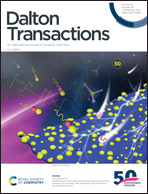Group 11 metal complexes of the dinucleating triazole appended bisphosphine 1,4-bis(5-(diisopropylphosphaneyl)-1-phenyl-1H-1,2,3-triazol-4-yl)benzene†
Abstract
The synthesis of a triazole appended dinucleating bisphosphine 1,4-bis(5-(diisopropylphosphaneyl)-1-phenyl-1H-1,2,3-triazol-4-yl)benzene (2) and its coinage metal complexes are described. The dinucleating bisphosphine 2 was obtained by the temperature-controlled lithiation of 1,4-bis(1-phenyl-1H-1,2,3-triazol-4-yl)benzene (1a) and 1,4-bis(1-(2-bromophenyl)-1H-1,2,3-triazol-4-yl)benzene (1b) followed by the reaction with iPr2PCl. The reactions of 2 with copper(I) halides in 1 : 2 molar ratios yielded the [Cu(μ2-X)]2 dimeric complexes [{Cu(μ2-X)}2(PiPr2N3PhC2)2C6H4] (3, X = Cl; 4, X = Br; and 5, X = I), whereas the reaction of 2 with AgBr resulted in the formation of hetero-cubane complex [{Ag4(μ3-Br)4}{(PiPr2N3PhC2)2C6H4}2] (7). Similar reactions of 2 with AgX in 1 : 2 molar ratios yielded disilver complexes [{Ag(μ2-X)}2{(PiPr2N3PhC2)2C6H4}] (6, X = Cl and 8, X = I). Treatment of 2 with AgOAc in a 1 : 2 molar ratio afforded a dinuclear complex [Ag2(μ2-OAc)2{(PiPr2N3PhC2)2(C6H4)}] (9) with one of the acetate ligands bridging the two metal centres in the side-on mode, whereas the other one adopting the end-on mode keeping the >C![[double bond, length as m-dash]](https://www.rsc.org/images/entities/char_e001.gif) O group uncoordinated. The reaction of 2 with two equivalents of [AuCl(SMe2)] afforded the digold complex [(AuClPiPr2N3PhC2)2C6H4] (10). The molecular structures of 2–5 and 7–10 were confirmed by single crystal X-ray analysis. Non-covalent interactions between Cu and Carene were observed in the molecular structures of 3, 4 and 5. These weak interactions were also assessed by DFT calculations in terms of their non-covalent interaction plots (NCI) and QTAIM analyses.
O group uncoordinated. The reaction of 2 with two equivalents of [AuCl(SMe2)] afforded the digold complex [(AuClPiPr2N3PhC2)2C6H4] (10). The molecular structures of 2–5 and 7–10 were confirmed by single crystal X-ray analysis. Non-covalent interactions between Cu and Carene were observed in the molecular structures of 3, 4 and 5. These weak interactions were also assessed by DFT calculations in terms of their non-covalent interaction plots (NCI) and QTAIM analyses.



 Please wait while we load your content...
Please wait while we load your content...